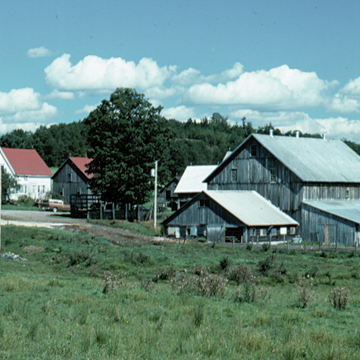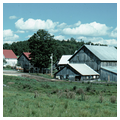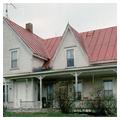The farmyard that Samuel Stanhope built c. 1890, after a fire consumed the existing house and barns on his farm, is a good example of a northwestern Vermont courtyard arrangement of buildings erected at the same time rather than over time. Characteristic of the type, the group of buildings sits at the end of a long straight drive and consists of, in clockwise order from north to south, a west-facing house with kitchen and woodshed ell, a farm shop, a slaughterhouse, a horse barn with a hog basement, and a large bank barn that faces north to the drive. The house is conservative in exterior design, with Greek Revival detailing and a simple Queen Anne porch, and the interior has the more open plan characteristic of the century's end, with no side hall and the stairway moved to the rear. The horse barn retains arched entrance trim for its stalls, and the great wooden slaughtering wheel still hangs in the slaughterhouse. The bank barn is of the Champlain Valley type, with ground stables and twin covered-bridge entrances on the eaves side accessing the interior haymow. Samuel farmed two hundred and fifty acres, kept three horses, twenty-five cows, fifteen other cattle, a dozen chickens, and tapped several hundred maples. He also kept ten or so swine, butchering and selling pork to his neighbors; of necessity, the slaughterhouse was a good distance behind the other buildings. His descendants continue to operate the dairy farm, updating the barn into a modern free-stall operation for one hundred cows with additional stalls and a milking parlor and bulk tank room.
You are here
Stanhope Farmyard
If SAH Archipedia has been useful to you, please consider supporting it.
SAH Archipedia tells the story of the United States through its buildings, landscapes, and cities. This freely available resource empowers the public with authoritative knowledge that deepens their understanding and appreciation of the built environment. But the Society of Architectural Historians, which created SAH Archipedia with University of Virginia Press, needs your support to maintain the high-caliber research, writing, photography, cartography, editing, design, and programming that make SAH Archipedia a trusted online resource available to all who value the history of place, heritage tourism, and learning.


















